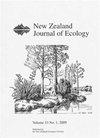Why have so few Māori or Moriori names been used in taxonomic description?
IF 1.4
3区 环境科学与生态学
Q3 ECOLOGY
引用次数: 9
Abstract
The listing by Veale et al. (2019) of taxonomic epithets based on te reo Maori and ta re Moriori show that there were very few until well into the 20th century and their approximate total to date of 1288 represents only about 4% of New Zealand species names. The bias against the use of indigenous names can be traced to the preference of eighteenth-century European scientists, and Linnaeus in particular, for their own scholarly languages, Latin and Greek, and their rejection of other languages as “barbarous.” As codes of zoological and botanical nomenclature were developed the European preference for Latin names in taxonomy became formalised and the use of indigenous names was discouraged. The dominance of Latin has only slowly been loosened. The term “barbarous” for names not from Latin or Greek remained in the International Code of Botanical Nomenclature until 1956 and the International Code of Zoological Nomenclature until 1961. Since then there have been no restrictions or recommendations in either code on the source or language of new species names, although they are still required to be in Latin form. Taxonomists are thus free to use te reo Maori, ta re Moriori or any language when naming species and in recent years more have been doing so, although the old European preference for imposing Latin names still persists.为什么在分类描述中使用的Māori或Moriori名字如此之少?
Veale等人(2019)基于reo Maori和ta re Moriori的分类名称列表表明,直到进入20世纪,它们的分类名称非常少,迄今为止它们的总数约为1288个,仅占新西兰物种名称的4%左右。对使用土著名称的偏见可以追溯到18世纪欧洲科学家,尤其是林奈,对他们自己的学术语言,拉丁语和希腊语的偏爱,以及他们对其他语言“野蛮”的排斥。随着动物和植物命名法代码的发展,欧洲人在分类学上对拉丁名字的偏好变得形式化,而使用本土名称则不受鼓励。拉丁语的主导地位只是慢慢被放松了。非拉丁或希腊名称的“野蛮”一词一直保留在1956年的《国际植物命名法典》和1961年的《国际动物命名法典》中。从那时起,在新物种名称的来源或语言方面,无论是代码还是建议都没有任何限制,尽管它们仍然被要求使用拉丁语形式。因此,分类学家在命名物种时可以自由地使用reo Maori, ta re Moriori或任何语言,近年来越来越多的人这样做,尽管古老的欧洲人仍然喜欢强加拉丁名称。
本文章由计算机程序翻译,如有差异,请以英文原文为准。
求助全文
约1分钟内获得全文
求助全文
来源期刊

New Zealand Journal of Ecology
环境科学-生态学
CiteScore
3.00
自引率
12.50%
发文量
35
审稿时长
>36 weeks
期刊介绍:
The New Zealand Journal of Ecology is a biannual peer-reviewed journal publishing ecological research relevant to New Zealand/Aotearoa and the South Pacific. It has been published since 1952 (as a 1952 issue of New Zealand Science Review and as the Proceedings of the New Zealand Ecological Society until 1977). The Journal is published by the New Zealand Ecological Society (Inc.), and is covered by Current Contents/Agriculture, Biology and Environmental Science, GEOBASE, and Geo Abstracts.
 求助内容:
求助内容: 应助结果提醒方式:
应助结果提醒方式:


